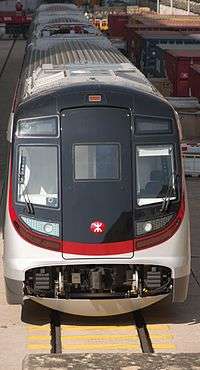MTR Hyundai Rotem EMU
| Hyundai Rotem EMU (R-Train) | |
|---|---|
|
MTR Hyundai Rotem EMU (Trainset 2, Car D006) parking at Lo Wu Marshaling Yard | |
| In service | 2018 - |
| Manufacturer | Hyundai Rotem |
| Replaced | Metro Cammell EMU (AC) |
| Constructed | 2013 - 2018 |
| Entered service | 2018 - 2020 |
| Number built | 333 (37 Vehicles) |
| Number in service | 37 |
| Formation | 9 cars per trainset |
| Fleet numbers | D001/D003 - D109/D111 |
| Operator(s) | MTR |
| Depot(s) | Ho Tung Lau, Fo Tan |
| Line(s) served | North South Corridor (Future) |
| Specifications | |
| Car body construction |
Aluminum Fiberglass(Header) |
| Car length |
25,000 mm (82 ft 0.3 in) (cars with driver cab) 24,136 mm (79 ft 2.2 in) (cars without driver cab) |
| Width | 3,220 mm (10 ft 6.8 in) |
| Height | 4,180 mm (13 ft 8.6 in) |
| Doors |
5 per side 2 per side (First Class) |
| Maximum speed |
Design 130 km/h (81 mph) Service 120 km/h (75 mph) |
| Traction system | IGBT-VVVF |
| Power output | 265 kW or 355 hp per motor |
| Acceleration | 1 m/s2 (3.3 ft/s2) |
| Deceleration |
Service 1.1 m/s2 (3.6 ft/s2), emergency 1.35 m/s2 (4.4 ft/s2) |
| Electric system(s) | 25 kV AC, 50 Hz Catenary |
| Current collection method | Pantograph |
| Braking system(s) | Pneumatic and Regenerative |
| Safety system(s) | ATO and ATP |
| Track gauge | 1,435 mm (4 ft 8 1⁄2 in) |
The Hyundai Rotem EMU (also known as R-Train) is a rolling stock order by MTR Hong Kong in December 2012 for the East Rail Line as part of the Sha Tin to Central Link extension, at a cost of HK$4 billion.[1] 37 trainsets will be delivered.[2] The first delivery took place in 2015.[3][4] All trainsets will in service by 2020.[2]
Exterior Design
Their design was the same from MTR CNR Changchun EMU which will be operating on South Island Line. However, their design at the First Class Compartment was using Yellow at the Doors to contrast as First Class and Standard Class.
Features


The Hyundai Rotem EMU train will be more advanced than the existing Metro Cammell EMU.
- Train doors on this stock are more evenly distributed, similar to pre-merger MTR trains. Seats near gangway connection are placed horizontally, making room for standing space. The new signaling system will also be compatible with future automatic platform gates on North-South Corridor.
- Train compartment will be wider than existing trains, increasing capacity.
- Exterior sliding doors and Light-Emitting Diode(LED) lighting system is used on this model
- 27-inch display screen is installed for MTR in-train TV
- Dynamic route maps and improved grab poles
- "Rugby-like" handrail
Formation
The formation ranges from D001/D003 to D109/D111. One car will still be reserved for the first class in each train set. The 9-car formation is shorter than the existing 12-car East Rail Line train. There are concerns that the new formation may worsen the existing overcrowding problem.[7][8] However, the Transport and Housing Bureau and MTRC suggest that the new signaling system and higher train speeds will increase the train frequency from three minutes down to two minutes. Also, after the completion of the Sha Tin to Central Link (Tai Wai - Hung Hom section) in 2019, 20% of the existing East Rail Line passengers will take the new East West Corridor.
References
- ↑ Barrow, Keith (19 December 2012). "MTR orders trains and signalling for Shatin – Central Link". International Railway Journal. Retrieved 28 July 2015.
- 1 2 "New Trains and Signalling System for the future Shatin to Central Link" (PDF). MTR (Press Release). 14 December 2012. Retrieved 28 July 2015.
- ↑ "2nd MTR shipment successful delivery". Pioneer Logistics Group. 19 December 2015. Retrieved 4 October 2016.
- 1 2 港鐵公司. "沙中綫新列車九月起到港" (PDF). Retrieved 2015-07-30.
- ↑ 沙中線韓製新列車曝光!車廂設動態路線圖,東方報業集團網站,2016年4月12日
- ↑ https://www.facebook.com/MTRiders/mediaset?album=pb.1550011891899273
- ↑ "LCQ1: Crowdedness in MTR train compartments". Hong Kong Government Press Release. Retrieved 15 August 2016.
- ↑ "東鐵線將減三卡車廂 市民質疑難加班次疏導". Stand News. Retrieved 15 August 2016.
